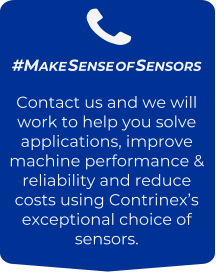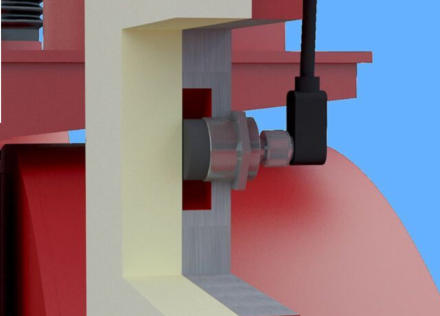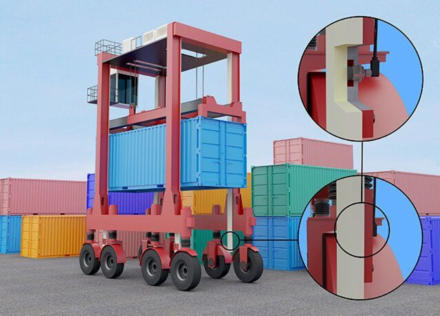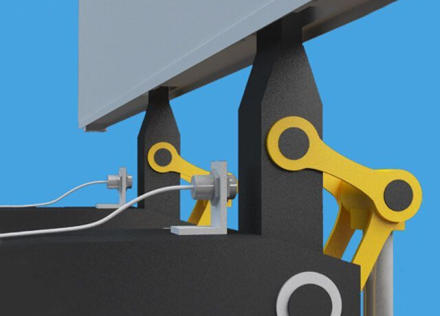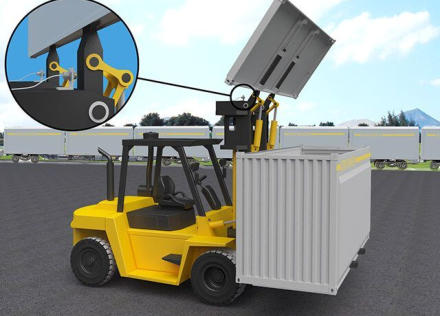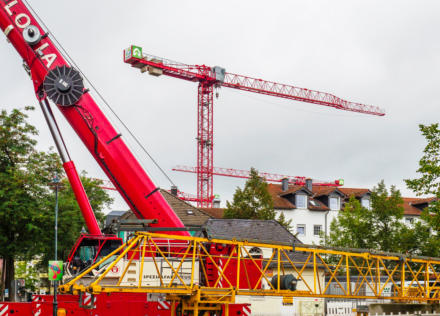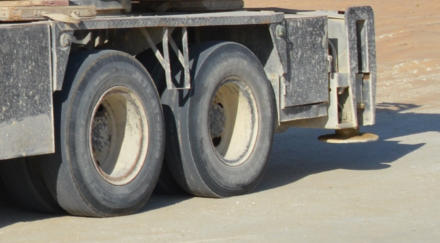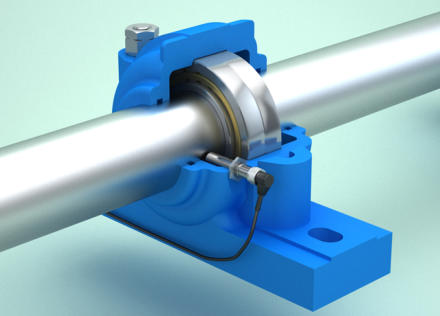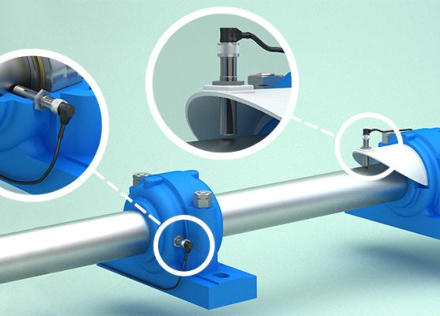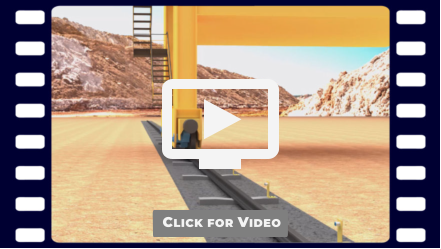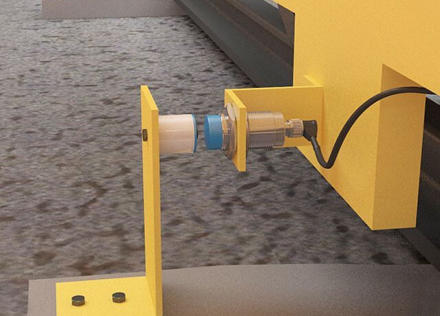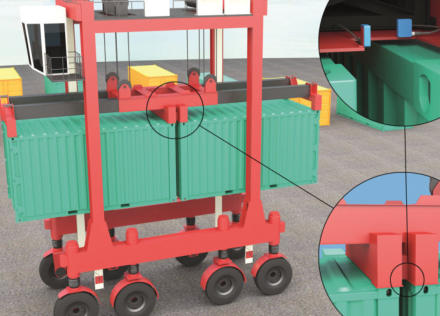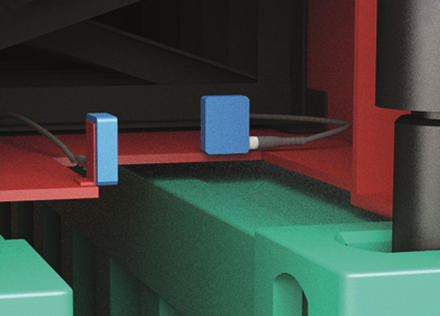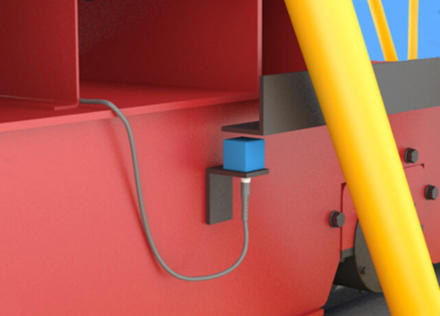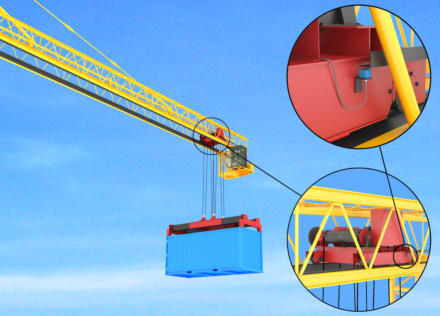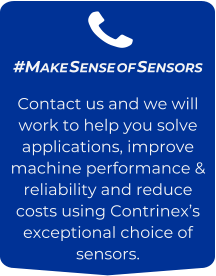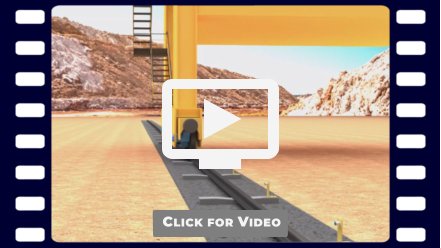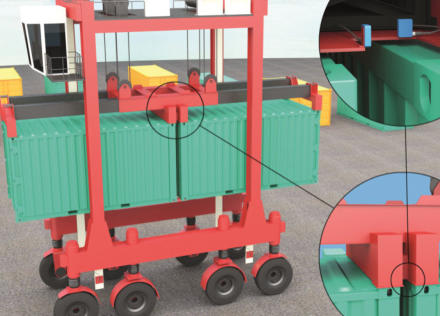(0121) 58 222 58 SALES@PLUSAUTOMATION.CO.UK

© 2021 - PLUS Automation Limited®

HELPING YOU #MAKE SENSE OF SENSORS
--







EXAMPLE APPLICATIONS
TO ILLUSTRATE THE WIDE-VARIETY OF APPLICATIONS SOLVED USING CONTRINEX SENSORS, WE HAVE POSTED A LARGE SELECTION OF EXAMPLE APPLICATIONS WHICH CAN BE SEEN BY CLICKING ON AN IMAGE. BELOW ARE A SELECTION OF SOME OF THESE APPLICATIONS: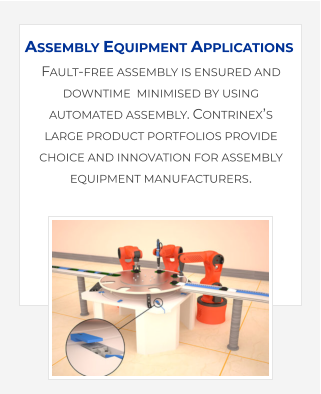
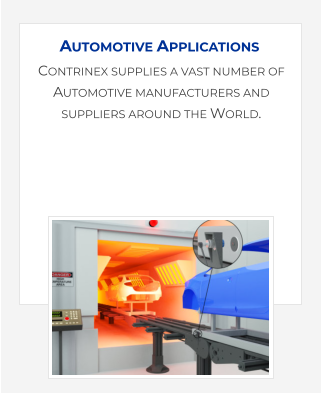

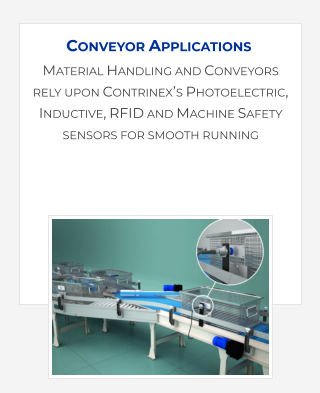
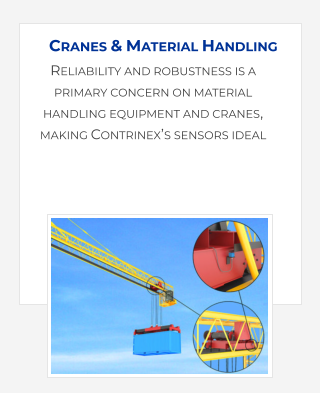
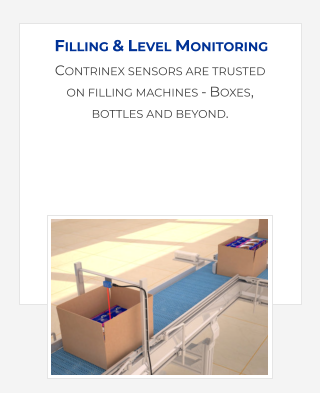
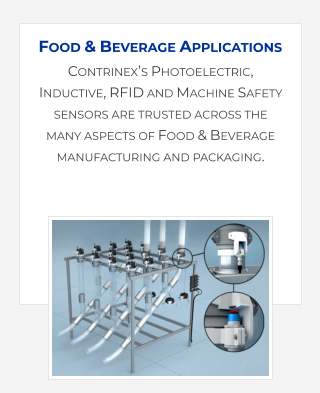
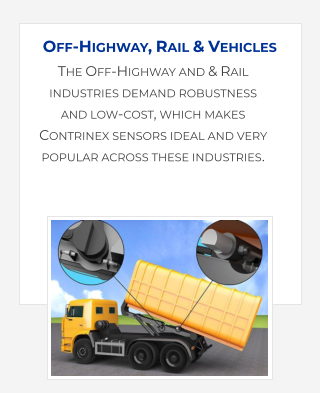
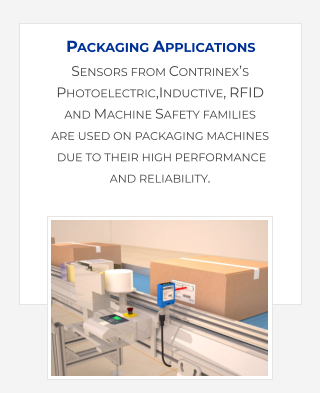
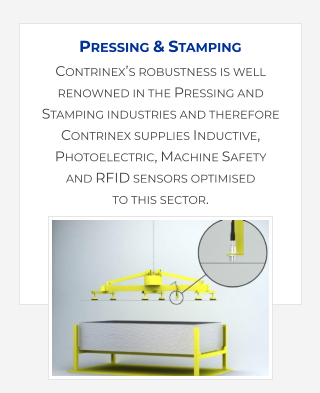
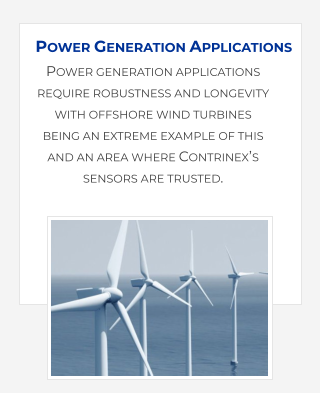
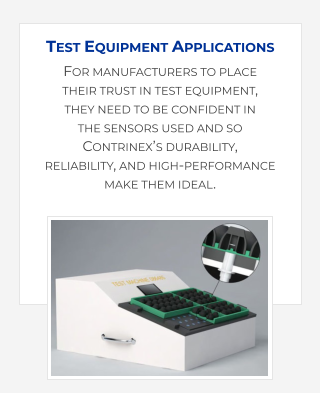

CUSTOMER VALUES
MAXIMUM VEHICLE UTILISATION WITH FEWER CONSTRAINTS
ON OPERATIONS
REAL-TIME INDICATION OF BEARING CONDITION AND WEAR
RATE
REDUCED MAINTENANCE COSTS WITH MINIMAL INCIDENCE OF
BREAKDOWNS
RELIABLE OPERATION IN A HIGHLY DEMANDING AND HARSH
ENVIRONMENT
PRODUCT ADVANTAGES
ANALOGUE DEVICE WITH EXTENDED 40MM SENSING RANGE
SMALL PHYSICAL SIZE (LESS THAN 50MM LENGTH)
EXCEPTIONAL ACCURACY AND RESOLUTION IN THE MICRON
RANGE
LONG LIFE, ESPECIALLY IN APPLICATIONS WITH TEMPERATURE
FLUCTUATIONS AND VIBRATIONS
Busy container seaports rely upon the ‘24/7’ operation of
specialist container-handling vehicles called Straddle Carriers
for loading, unloading and stacking containers. Often located
at ports, being beside the sea can mean that they have to work
in an aggressive and corrosive environment, requiring
frequent maintenance.
Because traditional, interval-based maintenance schedules are
not optimally efficient, condition-based intervention systems
which minimise the risk of breakdown, are popular. European
port operators therefore frequently rely upon Contrinex’s
rugged, analogue-output inductive sensors to monitor
components with a high risk of premature failure, maximising
vehicle utilisation and reducing maintenance costs.
CUSTOMER APPLICATION
A fleet of straddle carriers services a busy container port,
operating round the clock in a highly aggressive environment.
Frequent maintenance is necessary, but traditional, interval-
based maintenance schedules are not always optimal.
Condition-based intervention minimises the risk of
breakdowns, while imposing fewer constraints on day-to-day
operation; it also incurs cost only when necessary.
As a carrier moves over a container, a central spreader beam
lowers and locks onto the four corner fittings of the container.
Plain plastic bearings on the carrier legs guide the container as
it is raised; there is significant contamination from dirt and
other debris. Bearings wear rapidly in the all-weather
operating conditions.
A condition-monitoring system must measure bearing
thickness, repeatably and accurately, in realtime and with µm
resolution. Sensors must operate reliably in the harsh
environment with a minimum rating of IP67. Sensor length
must not exceed 70mm and a minimum sensing range of
30mm is mandatory.
CUSTOMER SOLUTION
Contrinex’s Analogue Inductive sensors, which feature ‘Extra
Distance’ technology are ideal for this demanding application.
These M30-diameter metal-bodied devices are IP67-rated and
provide an analogue voltage (0 to 10 volt) or current (4 to
20mA) output. The sensors are less than 50mm long with a
40mm sensing range, comfortably exceeding the specified
requirement.
A mild steel mounting plate, fixed immediately behind the
plastic bearing, locates each sensor with its sensing face in
contact with the rear surface of the bearing. As a container
passes over the front face of the bearing, the sensor measures
the distance to the metal container wall, and thus the bearing
thickness. Data is collected in real time with exceptional
accuracy and resolution in the micron range.
Data passes to on-board computers mounted on each carrier;
connection is via a flexible cable with an easily detachable M12
connector. At intervals, carriers transmit data wirelessly to a
central processor for detailed analysis.
The output gives a clear indication of the condition and wear
rate of each bearing, identifying any carrier requiring
maintenance. Consequently, the port operator has the means
to develop a genuine commercial advantage by eliminating
compromise from day-to-day operating processes

CUSTOMER VALUES
SAFE, RELIABLE PERFORMANCE IN A DEMANDING OUTDOOR
ENVIRONMENT
NO LIKELIHOOD OF ACCIDENTAL DAMAGE ARISING IN
OPERATION
COST-EFFECTIVE SOLUTION, MAINTENANCE FREE
PRODUCT ADVANTAGES
CORROSION-RESISTANT STAINLESS-STEEL SENSOR RATED TO
IP68 AND IP69K
COST-EFFECTIVE HIGH-PERFORMANCE SENSOR WITH
EXCEPTIONAL RELIABILITY
BEST-IN-CLASS 20MM SENSING DISTANCE IN M30-DIAMETER
HOUSING
CUSTOMER SOLUTION
Contrinex’s ‘Basic’ range of inductive sensors are highly suited
for this application. Mounted in rugged 40 x 40mm polyamide
glass-fibre housings, these devices from the ‘Classics’
technology family utilised a 20mm sensing distance that
eliminates the risk of collisions. A 40mm sensing distance is
also available for this sensor if needed and its IP68 / IP69K-
rating makes it ideal for the outdoor working environment,
even in a seaport.
The use of industry-standard housings for these Contrinex
sensors ensures that they are drop-in replacements for
competitor’s devices. No modification to the mounting
arrangements was necessary, incurring little downtime during
the changeover to the new sensing arrangements.
Communication with the crane’s control system is via a PNP
changeover interface, replacing the existing two-wire
arrangement; a flexible PUR-sheathed cable provides the
electrical connection. The new sensor features an integral S12
connector, allowing easy removal and replacement for
maintenance.
A step improvement in operational performance was evident
immediately after the new units were installed. The new
sensors provide reliable sensing of each hoist’s position with
no reported collisions since the date of installation. The
customer has reported a marked reduction in crane downtime
with an associated decrease in expenditure on replacement
sensors.
A container manufacturer uses a modified forklift, fitted with
two sets of forks, for unloading bulk cargo. The lower forks
support the container while the upper forks control the lid.
When unloading, the lid opens and the lower forks rotate,
tipping out the contents. A robust inductive sensor senses the
position of the lid, ensuring it opens fully before emptying.
CUSTOMER APPLICATION
Containers are often used when transporting bulk cargo,
including wood chip and biomass, by rail. A Swiss
manufacturer of bulk-cargo containers has developed an
innovative unloading system that uses only a modified forklift,
eliminating the need for specialist handling equipment.
The forklift has two pairs of lifting forks. The main forks,
mounted conventionally, support the weight of the container
as it is unloaded from a freight wagon; a second pair, mounted
vertically above the lower pair, opens and closes the lid of the
container. During opening, the upper forks lift the lid a short
distance before tilting it vertically, leaving the top of the
container completely unobstructed.
The lower forks then rotate about a horizontal axis, tilting the
container end-over-end and tipping the contents out. A robust
and reliable sensor system is required to detect the vertical
position of the lid before rotation begins. An extended sensing
distance is essential to eliminate the possibility of mechanical
damage.

CUSTOMER VALUES
NO READJUSTMENT OVER TIME
NO WEAR AND TEAR AND RELATIVELY TAMPER-PROOF
LONG TERM RELIABILITY
NO MAINTENANCE
PRODUCT ADVANTAGES
EASY ADJUSTMENT/SETUP
LOCAL ANNUNCIATION (LED INDICATOR)
AFFORDABLE SENSOR WITH EXCELLENT RELIABILITY
A manufacturer of mobile cranes uses Contrinex 2-wire
inductive sensors to detect the position of stabiliser legs as
part of the vehicle safety system. Before the system will allow
the driver to drive the vehicle away, sensors confirm that
stabiliser legs have been retracted.
CUSTOMER APPLICATION
Mobile cranes, telescopic handlers and the like are equipped
with extendable stabiliser legs to prevent them from tipping
over when lifting. These stabiliser legs (or jacks) are
mechanical extensions of the chassis which widen the base of
the vehicle’s chassis to ensure its stability in all operating
situations. However, when the time comes to move the vehicle,
there must be verification that these stabilisers are fully
retracted. Either an indicator in the driver’s cab or a method of
disabling engagement of the vehicle’s transmission is used to
ensure safety and prevent drive-away accidents and damage.
The customer’s existing verification system relies on
mechanical contacts. However, the costs of maintenance and
replacements over the long lifetime of such vehicles are
relatively high and hence a non-contact solution was sought
.
Customer Solution
A normally closed, two-wire inductive sensor from Contrinex’s
Classic 600 Series was ideal for this application. Multiple
sensors (one for each stabiliser cylinder) are installed and
connected in a way that requires each sensor to be satisfied
that a target is either present or absent, thus completing a
logic circuit.
Initially, the simplest approach would seem to be to wire this
group of devices in series, as would be the case with
mechanical contacts. However, when using sensors, series
wiring presents the challenge of voltage drops. The customer
overcomes this by selecting 2-wire sensors with a ‘normally
closed’ output, then wiring them in parallel to create a logical
NAND situation.
This wiring solution resolves the issue and permits an easy to
implement, non-contact, non-mechanical approach to
providing feedback for the warning or inhibiting mechanism
of the vehicle.
Contrinex Smart Sensors are utilised in condition-based
monitoring of critical rotating machinery. They monitor
multiple parameters in real-time, including unexpected levels
of vibration, increased bearing temperature or irregular radial
deflections of a shaft. These highly versatile sensors provide a
flexible, cost-effective solution that maximizes data availability
without adding complexity.
CUSTOMER APPLICATION
Engineers are always seeking ways to minimise machine
downtime without risking costly breakdowns. It is a dilemma
faced by engineers and designers worldwide, especially in
sectors like heavy industry, mining, marine engineering, oil
and gas, green energy and rail operations where rotating
machinery is common-place and the machinery is often
remotely located or inaccessible.
Bearing failure is a significant risk in equipment with rotating
elements and it is generally sign-posted in its early stages by
increased levels of vibration and a rise in bearing temperature.
Typically, this risk is managed by frequent inspection and
maintenance of bearings, but condition-based monitoring
(CBM) has become the preferred approach for cost-effective
maintenance operations. CBM uses sensor technology to
extract real-time data from machinery, developing a
performance profile that identifies potential failures before
they bring operations to a ‘grinding halt’.
Designers have to balance the desire to collect as much data
as possible, on vibration, deflection, temperature and
operating hours, which might all help predict an imminent
breakdown, while keeping cost and complexity to a minimum.
Specifying multiple sensors meets the data-collection needs,
but is a costly approach, often requiring significant
compromise in mechanical design.
CUSTOMER SOLUTION
Contrinex Multi-Mode Smart Sensors fulfil the application’s
requirements without compromise, using their multi-function
technology. A single Smart Sensor can monitor multiple
parameters including deflection, vibration, temperature, linear
position, angular displacement and cycle count. Each of these
measurements may be reported as process data or event data,
while cumulative operating parameters are recorded in the
sensor’s on-board storage.
The user-defined operating modes enable a single sensor to
provide a range of functions. On the rotating machinery, it is
mounted in either a bearing housing or adjacent to a shaft, to
monitor for unexpected levels of vibration, increased bearing
temperature or irregular radial deflections of the shaft.
The sensor’s IO-Link functionality provides plug-and-play
replacement of damaged sensors, without any loss of
functionality and without any need for configuration.
Dual-channel operation is another valuable feature of the
Smart Sensor range. Should a critical event occur, the sensor
delivers a high-speed notification directly to the control
system, bypassing the IO-Link communications channel and
initiating a shut-down sequence immediately. This avoids
further, costly damage and minimizes subsequent process
downtime.
Smart Sensors are exceptionally reliable, making them ideal for
installation in remote locations where day-to-day access can
be impossible. In wind turbines, rail cars, drag-lines, marine
powerplants, paper mills, drilling platforms, construction
equipment, heavy-duty pumps and a host of similar
installations, these highly versatile sensors tick all the boxes.
Contrinex inductive Smart Sensors are designed with the
needs of OEMs and System Integrators in mind to provide an
unobtrusive fit-and-forget solution. For flexible, cost-effective
CBM solutions that maximize data availability without adding
complexity, Contrinex Multi-Mode Smart Sensors deliver
complete peace of mind.

CUSTOMER VALUES
ROBUST, METAL-CASED SMART SENSORS ARE IDEAL FOR EASY
INTEGRATION
MULTI-CHANNEL MONITORING CIRCUITRY ALLOWS USERS TO
DEFINE CUSTOMIZED OUTPUT THRESHOLDS
SOPHISTICATED SENSING ELECTRONICS DELIVER HIGH-
PRECISION ANALOG OUTPUT SIGNALS
HIGH-SPEED DEVICE-TO-DEVICE COMMUNICATION ENABLES
DECENTRALIZED DATA-PROCESSING AND DECISION MAKING
SMART SENSORS ARE INDIVIDUALLY SHIELDED AND EMC
IMMUNE, ELIMINATING INTERFERENCE WHEN MULTIPLE
DEVICES OPERATE IN CLOSE PROXIMITY
PRODUCT ADVANTAGES
ROBUST, METAL-CASED INDUCTIVE SMART SENSORS ARE
IDEAL FOR EASY INTEGRATION
MULTI-CHANNEL MONITORING CIRCUITRY ALLOWS USERS TO
DEFINE 5 CUSTOMISED OUTPUT THRESHOLDS
SMART SENSORS ARE INDIVIDUALLY SHIELDED AND EMC
IMMUNE, ELIMINATING INTERFERENCE WHEN MULTIPLE
DEVICES OPERATE IN CLOSE PROXIMITY
DEDICATED SERVICE-DATA BLOCKS HOLD DEVICE-SPECIFIC
DATA INCLUDING PRODUCT ID, LOCATION & SERIAL NUMBER
VISIBLE LED INDICATORS ENABLE SENSORS TO SELF-IDENTIFY
ON DEMAND, SIMPLIFYING COMMISSIONING AND TROUBLE-
SHOOTING ROUTINES
INDUSTRY-STANDARD -25°C TO +70°C OPERATING RANGE
RELIABILITY AND ROBUSTNESS IS A PRIMARY CONCERN ON CRANES AND MATERIAL-
HANDLING EQUIPMENT, WHICH MAKES CONTRINEX’S HIGH-PERFORMANCE SENSORS IDEAL.
CRANES & MATERIAL-HANDLING APPLICATIONS
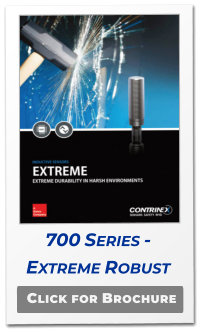
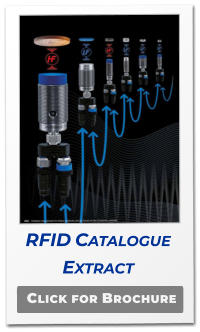
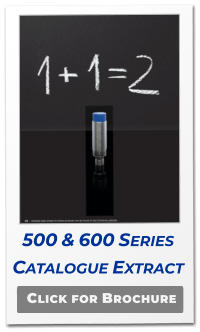
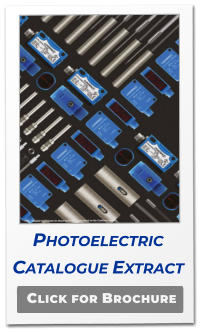

CUSTOMER VALUES
UNINTERRUPTED PRODUCTION AS POSITIONAL
IDENTIFICATION IS HIGHLY RELIABLE.
NO RISK OF SKEWING AS MOVEMENT OF THE MACHINE
STRUCTURE IS SYNCHRONISED.
ELIMINATION OF COLLISION DAMAGE BECAUSE OF SENSING
DISTANCE UP TO 45MM.
PRODUCT ADVANTAGES
PASSIVE RFID TRANSPONDER TAGS REQUIRE NO POWER
SOURCE AND MINIMAL MAINTENANCE.
RUGGED RFID TRANSPONDER TAGS WITH NYLON OR ALL-
METAL HOUSINGS SEALED TO IP67.
CONIDENT® TECHNOLOGY PROVIDES EXTENDED SENSING
RANGE ≤ 45MM.
READ/WRITE UNITS INTERFACE WITH A CHOICE OF INDUSTRY-
STANDARD CONTROL SYSTEMS OR IO-LINK
CUSTOMER SOLUTION
Contrinex high-frequency RFID read/write modules and
30mm-diameter RFID transponder tags are ideal for this
application. Rated up to IP67, the M30-diameter read/write
modules have PBTP sensing faces and V2A stainless-steel
housings, making them ideal for the demanding environment.
The ConIdent® passive transponders require no internal power
source and, with PBTP synthetic housings, have the same IP67
rating. The selected combination provides read/write distances
of up to 45mm (nearly 2 in), ideal for the specified operating
conditions. Tags are mounted at one-meter intervals along
each travel rail, each programmed with a unique identification
number.
As the machine passes a tag, the read/write module reads its
identification number at high speed; this is transmitted via a
PROFIBUS DP interface to the customer’s control system. A
simple look-up table confirms the location of the tag and thus
the position of the machine, allowing movement of both sides
of the structure to be synchronized without skewing.
Operation is independent of the direction of travel.
Contrinex ConIdent® RFID devices allow accurate and highly
reliable sensing of machine position and the long sensing
distance avoids any risk of collision damage. The customer
enjoys extended service life and robustness not available from
alternative position-detection systems, together with excellent
value for money
A manufacturer of bulk material-handling equipment uses
Contrinex Radio Frequency IDentification (RFID) technology to
sense the position of a large rail-mounted reclamation-
conveyor operating in a hot, dusty environment. A pair of read-
write modules, mounted on the machine structure,
interrogates a series of RFID tags, positioned at one-meter
intervals along each travel rail. The control system identifies
each tag individually and determines the exact position of the
machinery.
CUSTOMER APPLICATION
During surface-mining operations, large mobile reclamation
machines are used to recover bulk materials. On each
machine, a bucket-wheel excavator collects material and
deposits it onto a conveyor. As an area is cleared of material,
the machine moves along parallel steel travel rails to the next
area, allowing continuous operation without interruptions for
machine repositioning.
The distance between the travel rails is around 100 metres (300
ft) and travel speeds may reach 2m/sec (4.5 mph). If machine
movement along the two rails is not controlled accurately, the
two sides of the structure become misaligned, causing the
machine to skew. In this event, production is halted while the
machine is realigned; in the worst case, costly damage occurs.
A sensing system is required that detects the position of each
side of the machine structure accurately and reliably along the
entire length of the travel rails, allowing coordinated control of
the drive systems. Sensors must accommodate up to 10mm
lateral movement of the machine structure across either rail
and must withstand the hot, dusty environment of a desert
climate.
I

CUSTOMER VALUES
NON-CONTACT, ALL-ELECTRONIC DEVICE WITH SENSING
RANGE UP TO 500MM.
LARGE SENSING RANGE AVAILABLE IN A PHYSICALLY SMALL
SENSOR.• EXCEPTIONAL RESISTANCE TO EXTREME VIBRATION
DURING OPERATION.
OPTIMAL SPACE UTILISATION WITH LITTLE OR NO RELIANCE
ON OPERATOR INVOLVEMENT
PRODUCT ADVANTAGES
ELIMINATION OF CALIBRATION ERRORS DURING NORMAL
OPERATION
LARGE SENSING RANGE AVAILABLE IN PHYSICALLY SMALL
SENSOR
PROVIDES RELIABLE, REPEATABLE SENSING IN DEMANDING
OPERATING CONDITIONS
At busy container seaports, purpose-designed container-
handling vehicles called Straddle Carriers, operate around the
clock, loading, unloading and stacking containers. Space
utilisation is increasingly important and correctly identifying
the size of container picked for each lift is essential for
efficiency.
Contrinex photoelectric sensors have been fitted to the
Straddle Carriers to detect the container size and eliminate the
need for drivers to carry out identification checks, saving time
and avoiding errors.
CUSTOMER APPLICATION
A fleet of straddle carriers, purpose-designed container-
handling vehicles, services a busy French container port. As a
straddle carrier moves over a container, a central lifting beam
lowers and locks onto the corner castings of the container;
each lift comprises either a single 40-foot container or two 20-
foot containers.
Optimal utilisation of storage space is essential; correctly
identifying the size of container picked for each lift is vital.
Fitting carriers with sensors that detect the size and type of
containers at the time of lifting eliminate the need for drivers
to carry out identification checks, saving time and avoiding
errors.
The original mechanical sensors proved unreliable, losing
calibration when subjected to continuous vibration during
normal operation. Although the scheduled maintenance
interval for each vehicle is 1,000 hours, mechanical sensors
required recalibration at intervals of no more than two or three
days. A highly stable replacement sensor system was required.
CUSTOMER SOLUTION
Highly stable, non-contact, all-electronic units from the
Contrinex range of photoelectric sensors provide a reliable and
cost-effective alternative. The moulded-resin sensor casings,
fitted with coated-plastic sensing faces, are IP67 rated, making
them virtually impervious to the harsh, salt-laden environment
of a busy container port. Connection to the vehicle’s control
systems is via an integral M12 connector and PVC-sheathed
cable, allowing easy removal and replacement during routine
maintenance.
To confirm the size of the container, two pairs of diffuse
sensors with background suppression are mounted centrally
on each lifting beam. As the lifting beam descends, one sensor
from each pair detects the presence or absence of corner
castings at the central lifting points, while the other detects
the presence or absence of the gap between two 20-foot
containers. The combination of the two eliminates incorrect
identification in the unlikely event that the first sensor returns
a false-positive signal from a 40-foot container.
A physically small housing and long sensing distances
eliminate the risk of accidental damage arising from a
mechanical collision, while rugged industry-standard housings
and vacuum-encapsulated electronics minimise the effects of
vibration.
Operational results have been excellent; the new Contrinex
sensors have eliminated calibration errors and reduced
maintenance costs significantly.

CUSTOMER VALUES
RELIABLE SENSING OF HOIST-CARRIAGE POSITION IN BUSY
CONTAINER SEAPORT
SIGNIFICANT REDUCTION IN CRANE DOWNTIME
MARKED DECREASE IN MAINTENANCE COSTS FOR
REPLACEMENT SENSORS
PRODUCT ADVANTAGES
IP68 AND IP69K RATING
COST-EFFECTIVE HIGH-PERFORMANCE SENSOR WITH
EXCEPTIONAL RELIABILITY
SENSING DISTANCES UP TO 40MM IN INDUSTRY-STANDARD
40 X 40MM HOUSING
CUSTOMER SOLUTION
Contrinex’s ‘Basic’ range of inductive sensors are highly suited
for this application. Mounted in rugged 40 x 40mm polyamide
glass-fibre housings, these devices from the ‘Classics’
technology family utilised a 20mm sensing distance that
eliminates the risk of collisions. A 40mm sensing distance is
also available for this sensor if needed and its IP68 / IP69K-
rating makes it ideal for the outdoor working environment,
even in a seaport.
The use of industry-standard housings for these Contrinex
sensors ensures that they are drop-in replacements for
competitor’s devices. No modification to the mounting
arrangements was necessary, incurring little downtime during
the changeover to the new sensing arrangements.
Communication with the crane’s control system is via a PNP
changeover interface, replacing the existing two-wire
arrangement; a flexible PUR-sheathed cable provides the
electrical connection. The new sensor features an integral S12
connector, allowing easy removal and replacement for
maintenance.
A step improvement in operational performance was evident
immediately after the new units were installed. The new
sensors provide reliable sensing of each hoist’s position with
no reported collisions since the date of installation. The
customer has reported a marked reduction in crane downtime
with an associated decrease in expenditure on replacement
sensors.
Container-handling cranes in Britain’s busy seaports operate
around the clock relying upon Contrinex’s rugged inductive
sensors on each hoist carriage to detect its position with
respect to the crane structure and prevent it travelling outside
preset limits. Because mechanical play in the hoist carriage
allows a small amount of lateral drift as it travels along the
crane structure, Contrinex’s long sensing distance is essential
to prevent the sensor colliding with the crane structure.
CUSTOMER APPLICATION
Loading and unloading containers in a busy British seaport is a
24-hour activity, all year round, with optimum utilisation of
storage space being essential to achieve maximum operating
efficiency.
Container-handling cranes operate above a storage area,
positioning containers before lowering them into place. The
hoist carriage on each crane travels along the length of the
crane structure, traversing the width of the storage area to
achieve complete coverage of the available storage space.
Sensors fitted to the hoist carriage detect the ends of the
structure, cutting power to the drive-motors and preventing
the carriage from travelling beyond allowable limits.
Mechanical play in the drive system results in the carriage
drifting laterally as it travels along the crane structure. The
15mm sensing range of a competitor’s sensors were
inadequate; occasionally causing sensors to collide with the
crane’s structure, causing damage and interrupting operation.
Better inductive sensors with increased sensing range are
needed to prevent collisions.
WELCOME TO PLUS AUTOMATION LTD - EXPERTS IN SENSORS, WE WILL WORK TO HELP YOU
SOLVE YOUR APPLICATIONS, IMPROVE MACHINE PERFORMANCE & RELIABILITY AND REDUCE COSTS
USING CONTRINEX’S EXCEPTIONAL SENSORS - LET US HELP YOU #MAKE SENSE OF SENSORS



--








CUSTOMER VALUES
NO READJUSTMENT OVER TIME
NO WEAR AND TEAR AND RELATIVELY TAMPER-PROOF
LONG TERM RELIABILITY
NO MAINTENANCE
PRODUCT ADVANTAGES
EASY ADJUSTMENT/SETUP
LOCAL ANNUNCIATION (LED INDICATOR)
AFFORDABLE SENSOR WITH EXCELLENT RELIABILITY
A manufacturer of mobile cranes uses Contrinex 2-wire
inductive sensors to detect the position of stabiliser legs as
part of the vehicle safety system. Before the system will allow
the driver to drive the vehicle away, sensors confirm that
stabiliser legs have been retracted.
CUSTOMER APPLICATION
Mobile cranes, telescopic handlers and the like are equipped
with extendable stabiliser legs to prevent them from tipping
over when lifting. These stabiliser legs (or jacks) are
mechanical extensions of the chassis which widen the base of
the vehicle’s chassis to ensure its stability in all operating
situations. However, when the time comes to move the vehicle,
there must be verification that these stabilisers are fully
retracted. Either an indicator in the driver’s cab or a method of
disabling engagement of the vehicle’s transmission is used to
ensure safety and prevent drive-away accidents and damage.
The customer’s existing verification system relies on
mechanical contacts. However, the costs of maintenance and
replacements over the long lifetime of such vehicles are
relatively high and hence a non-contact solution was sought
.
Customer Solution
A normally closed, two-wire inductive sensor from Contrinex’s
Classic 600 Series was ideal for this application. Multiple
sensors (one for each stabiliser cylinder) are installed and
connected in a way that requires each sensor to be satisfied
that a target is either present or absent, thus completing a
logic circuit.
Initially, the simplest approach would seem to be to wire this
group of devices in series, as would be the case with
mechanical contacts. However, when using sensors, series
wiring presents the challenge of voltage drops. The customer
overcomes this by selecting 2-wire sensors with a ‘normally
closed’ output, then wiring them in parallel to create a logical
NAND situation.
This wiring solution resolves the issue and permits an easy to
implement, non-contact, non-mechanical approach to
providing feedback for the warning or inhibiting mechanism
of the vehicle.
Contrinex Smart Sensors are utilised in condition-based
monitoring of critical rotating machinery. They monitor
multiple parameters in real-time, including unexpected levels
of vibration, increased bearing temperature or irregular radial
deflections of a shaft. These highly versatile sensors provide a
flexible, cost-effective solution that maximizes data availability
without adding complexity.
CUSTOMER APPLICATION
Engineers are always seeking ways to minimise machine
downtime without risking costly breakdowns. It is a dilemma
faced by engineers and designers worldwide, especially in
sectors like heavy industry, mining, marine engineering, oil
and gas, green energy and rail operations where rotating
machinery is common-place and the machinery is often
remotely located or inaccessible.
Bearing failure is a significant risk in equipment with rotating
elements and it is generally sign-posted in its early stages by
increased levels of vibration and a rise in bearing temperature.
Typically, this risk is managed by frequent inspection and
maintenance of bearings, but condition-based monitoring
(CBM) has become the preferred approach for cost-effective
maintenance operations. CBM uses sensor technology to
extract real-time data from machinery, developing a
performance profile that identifies potential failures before
they bring operations to a ‘grinding halt’.
Designers have to balance the desire to collect as much data
as possible, on vibration, deflection, temperature and
operating hours, which might all help predict an imminent
breakdown, while keeping cost and complexity to a minimum.
Specifying multiple sensors meets the data-collection needs,
but is a costly approach, often requiring significant
compromise in mechanical design.
CUSTOMER SOLUTION
Contrinex Multi-Mode Smart Sensors fulfil the application’s
requirements without compromise, using their multi-function
technology. A single Smart Sensor can monitor multiple
parameters including deflection, vibration, temperature, linear
position, angular displacement and cycle count. Each of these
measurements may be reported as process data or event data,
while cumulative operating parameters are recorded in the
sensor’s on-board storage.
The user-defined operating modes enable a single sensor to
provide a range of functions. On the rotating machinery, it is
mounted in either a bearing housing or adjacent to a shaft, to
monitor for unexpected levels of vibration, increased bearing
temperature or irregular radial deflections of the shaft.
The sensor’s IO-Link functionality provides plug-and-play
replacement of damaged sensors, without any loss of
functionality and without any need for configuration.
Dual-channel operation is another valuable feature of the
Smart Sensor range. Should a critical event occur, the sensor
delivers a high-speed notification directly to the control
system, bypassing the IO-Link communications channel and
initiating a shut-down sequence immediately. This avoids
further, costly damage and minimizes subsequent process
downtime.
Smart Sensors are exceptionally reliable, making them ideal for
installation in remote locations where day-to-day access can
be impossible. In wind turbines, rail cars, drag-lines, marine
powerplants, paper mills, drilling platforms, construction
equipment, heavy-duty pumps and a host of similar
installations, these highly versatile sensors tick all the boxes.
Contrinex inductive Smart Sensors are designed with the
needs of OEMs and System Integrators in mind to provide an
unobtrusive fit-and-forget solution. For flexible, cost-effective
CBM solutions that maximize data availability without adding
complexity, Contrinex Multi-Mode Smart Sensors deliver
complete peace of mind.

CUSTOMER VALUES
ROBUST, METAL-CASED SMART SENSORS ARE IDEAL FOR EASY
INTEGRATION
MULTI-CHANNEL MONITORING CIRCUITRY ALLOWS USERS TO
DEFINE CUSTOMIZED OUTPUT THRESHOLDS
SOPHISTICATED SENSING ELECTRONICS DELIVER HIGH-
PRECISION ANALOG OUTPUT SIGNALS
HIGH-SPEED DEVICE-TO-DEVICE COMMUNICATION ENABLES
DECENTRALIZED DATA-PROCESSING AND DECISION MAKING
SMART SENSORS ARE INDIVIDUALLY SHIELDED AND EMC
IMMUNE, ELIMINATING INTERFERENCE WHEN MULTIPLE
DEVICES OPERATE IN CLOSE PROXIMITY
PRODUCT ADVANTAGES
ROBUST, METAL-CASED INDUCTIVE SMART SENSORS ARE
IDEAL FOR EASY INTEGRATION
MULTI-CHANNEL MONITORING CIRCUITRY ALLOWS USERS TO
DEFINE 5 CUSTOMISED OUTPUT THRESHOLDS
SMART SENSORS ARE INDIVIDUALLY SHIELDED AND EMC
IMMUNE, ELIMINATING INTERFERENCE WHEN MULTIPLE
DEVICES OPERATE IN CLOSE PROXIMITY
DEDICATED SERVICE-DATA BLOCKS HOLD DEVICE-SPECIFIC
DATA INCLUDING PRODUCT ID, LOCATION & SERIAL NUMBER
VISIBLE LED INDICATORS ENABLE SENSORS TO SELF-IDENTIFY
ON DEMAND, SIMPLIFYING COMMISSIONING AND TROUBLE-
SHOOTING ROUTINES
INDUSTRY-STANDARD -25°C TO +70°C OPERATING RANGE
Cranes &
Material-Handling
Applications
RELIABILITY AND ROBUSTNESS IS A PRIMARY
CONCERN ON CRANES AND MATERIAL HANDLING
EQUIPMENT, WHICH MAKES CONTRINEX’S
HIGH-PERFORMANCE SENSORS IDEAL.
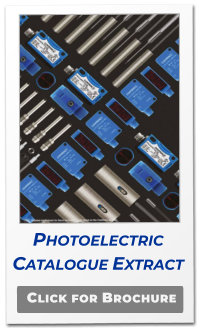
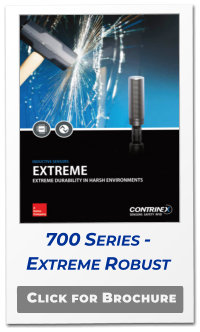
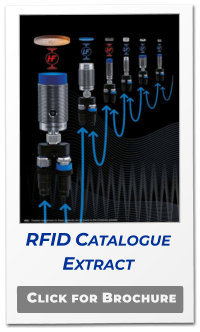
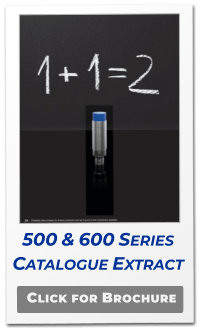

CUSTOMER VALUES
UNINTERRUPTED PRODUCTION AS POSITIONAL
IDENTIFICATION IS HIGHLY RELIABLE.
NO RISK OF SKEWING AS MOVEMENT OF THE MACHINE
STRUCTURE IS SYNCHRONISED.
ELIMINATION OF COLLISION DAMAGE BECAUSE OF SENSING
DISTANCE UP TO 45MM.
PRODUCT ADVANTAGES
PASSIVE RFID TRANSPONDER TAGS REQUIRE NO POWER
SOURCE AND MINIMAL MAINTENANCE.
RUGGED RFID TRANSPONDER TAGS WITH NYLON OR ALL-
METAL HOUSINGS SEALED TO IP67.
CONIDENT® TECHNOLOGY PROVIDES EXTENDED SENSING
RANGE ≤ 45MM.
READ/WRITE UNITS INTERFACE WITH A CHOICE OF INDUSTRY-
STANDARD CONTROL SYSTEMS OR IO-LINK
CUSTOMER SOLUTION
Contrinex high-frequency RFID read/write modules and
30mm-diameter RFID transponder tags are ideal for this
application. Rated up to IP67, the M30-diameter read/write
modules have PBTP sensing faces and V2A stainless-steel
housings, making them ideal for the demanding environment.
The ConIdent® passive transponders require no internal power
source and, with PBTP synthetic housings, have the same IP67
rating. The selected combination provides read/write distances
of up to 45mm (nearly 2 in), ideal for the specified operating
conditions. Tags are mounted at one-meter intervals along
each travel rail, each programmed with a unique identification
number.
As the machine passes a tag, the read/write module reads its
identification number at high speed; this is transmitted via a
PROFIBUS DP interface to the customer’s control system. A
simple look-up table confirms the location of the tag and thus
the position of the machine, allowing movement of both sides
of the structure to be synchronized without skewing.
Operation is independent of the direction of travel.
Contrinex ConIdent® RFID devices allow accurate and highly
reliable sensing of machine position and the long sensing
distance avoids any risk of collision damage. The customer
enjoys extended service life and robustness not available from
alternative position-detection systems, together with excellent
value for money
A manufacturer of bulk material-handling equipment uses
Contrinex Radio Frequency IDentification (RFID) technology to
sense the position of a large rail-mounted reclamation-
conveyor operating in a hot, dusty environment. A pair of read-
write modules, mounted on the machine structure,
interrogates a series of RFID tags, positioned at one-meter
intervals along each travel rail. The control system identifies
each tag individually and determines the exact position of the
machinery.
CUSTOMER APPLICATION
During surface-mining operations, large mobile reclamation
machines are used to recover bulk materials. On each
machine, a bucket-wheel excavator collects material and
deposits it onto a conveyor. As an area is cleared of material,
the machine moves along parallel steel travel rails to the next
area, allowing continuous operation without interruptions for
machine repositioning.
The distance between the travel rails is around 100 metres (300
ft) and travel speeds may reach 2m/sec (4.5 mph). If machine
movement along the two rails is not controlled accurately, the
two sides of the structure become misaligned, causing the
machine to skew. In this event, production is halted while the
machine is realigned; in the worst case, costly damage occurs.
A sensing system is required that detects the position of each
side of the machine structure accurately and reliably along the
entire length of the travel rails, allowing coordinated control of
the drive systems. Sensors must accommodate up to 10mm
lateral movement of the machine structure across either rail
and must withstand the hot, dusty environment of a desert
climate.

CUSTOMER VALUES
RELIABLE SENSING OF HOIST-CARRIAGE POSITION IN BUSY
CONTAINER SEAPORT
SIGNIFICANT REDUCTION IN CRANE DOWNTIME
MARKED DECREASE IN MAINTENANCE COSTS FOR
REPLACEMENT SENSORS
PRODUCT ADVANTAGES
IP68 AND IP69K RATING
COST-EFFECTIVE HIGH-PERFORMANCE SENSOR WITH
EXCEPTIONAL RELIABILITY
SENSING DISTANCES UP TO 40MM IN INDUSTRY-STANDARD
40 X 40MM HOUSING
CUSTOMER SOLUTION
Contrinex’s ‘Basic’ range of inductive sensors are highly suited
for this application. Mounted in rugged 40 x 40mm polyamide
glass-fibre housings, these devices from the ‘Classics’
technology family utilised a 20mm sensing distance that
eliminates the risk of collisions. A 40mm sensing distance is
also available for this sensor if needed and its IP68 / IP69K-
rating makes it ideal for the outdoor working environment,
even in a seaport.
The use of industry-standard housings for these Contrinex
sensors ensures that they are drop-in replacements for
competitor’s devices. No modification to the mounting
arrangements was necessary, incurring little downtime during
the changeover to the new sensing arrangements.
Communication with the crane’s control system is via a PNP
changeover interface, replacing the existing two-wire
arrangement; a flexible PUR-sheathed cable provides the
electrical connection. The new sensor features an integral S12
connector, allowing easy removal and replacement for
maintenance.
A step improvement in operational performance was evident
immediately after the new units were installed. The new
sensors provide reliable sensing of each hoist’s position with
no reported collisions since the date of installation. The
customer has reported a marked reduction in crane downtime
with an associated decrease in expenditure on replacement
sensors.
Container-handling cranes in Britain’s busy seaports operate
around the clock relying upon Contrinex’s rugged inductive
sensors on each hoist carriage to detect its position with
respect to the crane structure and prevent it travelling outside
preset limits. Because mechanical play in the hoist carriage
allows a small amount of lateral drift as it travels along the
crane structure, Contrinex’s long sensing distance is essential
to prevent the sensor colliding with the crane structure.
CUSTOMER APPLICATION
Loading and unloading containers in a busy British seaport is a
24-hour activity, all year round, with optimum utilisation of
storage space being essential to achieve maximum operating
efficiency.
Container-handling cranes operate above a storage area,
positioning containers before lowering them into place. The
hoist carriage on each crane travels along the length of the
crane structure, traversing the width of the storage area to
achieve complete coverage of the available storage space.
Sensors fitted to the hoist carriage detect the ends of the
structure, cutting power to the drive-motors and preventing
the carriage from travelling beyond allowable limits.
Mechanical play in the drive system results in the carriage
drifting laterally as it travels along the crane structure. The
15mm sensing range of a competitor’s sensors were
inadequate; occasionally causing sensors to collide with the
crane’s structure, causing damage and interrupting operation.
Better inductive sensors with increased sensing range are
needed to prevent collisions.
I

CUSTOMER VALUES
NON-CONTACT, ALL-ELECTRONIC DEVICE WITH SENSING
RANGE UP TO 500MM.
LARGE SENSING RANGE AVAILABLE IN A PHYSICALLY SMALL
SENSOR.• EXCEPTIONAL RESISTANCE TO EXTREME VIBRATION
DURING OPERATION.
OPTIMAL SPACE UTILISATION WITH LITTLE OR NO RELIANCE
ON OPERATOR INVOLVEMENT
PRODUCT ADVANTAGES
ELIMINATION OF CALIBRATION ERRORS DURING NORMAL
OPERATION
LARGE SENSING RANGE AVAILABLE IN PHYSICALLY SMALL
SENSOR
PROVIDES RELIABLE, REPEATABLE SENSING IN DEMANDING
OPERATING CONDITIONS
At busy container seaports, purpose-designed container-
handling vehicles called Straddle Carriers, operate around the
clock, loading, unloading and stacking containers. Space
utilisation is increasingly important and correctly identifying
the size of container picked for each lift is essential for
efficiency.
Contrinex photoelectric sensors have been fitted to the
Straddle Carriers to detect the container size and eliminate the
need for drivers to carry out identification checks, saving time
and avoiding errors.
CUSTOMER APPLICATION
A fleet of straddle carriers, purpose-designed container-
handling vehicles, services a busy French container port. As a
straddle carrier moves over a container, a central lifting beam
lowers and locks onto the corner castings of the container;
each lift comprises either a single 40-foot container or two 20-
foot containers.
Optimal utilisation of storage space is essential; correctly
identifying the size of container picked for each lift is vital.
Fitting carriers with sensors that detect the size and type of
containers at the time of lifting eliminate the need for drivers
to carry out identification checks, saving time and avoiding
errors.
The original mechanical sensors proved unreliable, losing
calibration when subjected to continuous vibration during
normal operation. Although the scheduled maintenance
interval for each vehicle is 1,000 hours, mechanical sensors
required recalibration at intervals of no more than two or three
days. A highly stable replacement sensor system was required.
CUSTOMER SOLUTION
Highly stable, non-contact, all-electronic units from the
Contrinex range of photoelectric sensors provide a reliable and
cost-effective alternative. The moulded-resin sensor casings,
fitted with coated-plastic sensing faces, are IP67 rated, making
them virtually impervious to the harsh, salt-laden environment
of a busy container port. Connection to the vehicle’s control
systems is via an integral M12 connector and PVC-sheathed
cable, allowing easy removal and replacement during routine
maintenance.
To confirm the size of the container, two pairs of diffuse
sensors with background suppression are mounted centrally
on each lifting beam. As the lifting beam descends, one sensor
from each pair detects the presence or absence of corner
castings at the central lifting points, while the other detects
the presence or absence of the gap between two 20-foot
containers. The combination of the two eliminates incorrect
identification in the unlikely event that the first sensor returns
a false-positive signal from a 40-foot container.
A physically small housing and long sensing distances
eliminate the risk of accidental damage arising from a
mechanical collision, while rugged industry-standard housings
and vacuum-encapsulated electronics minimise the effects of
vibration.
Operational results have been excellent; the new Contrinex
sensors have eliminated calibration errors and reduced
maintenance costs significantly.

CUSTOMER VALUES
SAFE, RELIABLE PERFORMANCE IN A DEMANDING OUTDOOR
ENVIRONMENT
NO LIKELIHOOD OF ACCIDENTAL DAMAGE ARISING IN
OPERATION
COST-EFFECTIVE SOLUTION, MAINTENANCE FREE
PRODUCT ADVANTAGES
CORROSION-RESISTANT STAINLESS-STEEL SENSOR RATED TO
IP68 AND IP69K
COST-EFFECTIVE HIGH-PERFORMANCE SENSOR WITH
EXCEPTIONAL RELIABILITY
BEST-IN-CLASS 20MM SENSING DISTANCE IN M30-DIAMETER
HOUSING
CUSTOMER SOLUTION
Contrinex’s ‘Basic’ range of inductive sensors are highly suited
for this application. Mounted in rugged 40 x 40mm polyamide
glass-fibre housings, these devices from the ‘Classics’
technology family utilised a 20mm sensing distance that
eliminates the risk of collisions. A 40mm sensing distance is
also available for this sensor if needed and its IP68 / IP69K-
rating makes it ideal for the outdoor working environment,
even in a seaport.
The use of industry-standard housings for these Contrinex
sensors ensures that they are drop-in replacements for
competitor’s devices. No modification to the mounting
arrangements was necessary, incurring little downtime during
the changeover to the new sensing arrangements.
Communication with the crane’s control system is via a PNP
changeover interface, replacing the existing two-wire
arrangement; a flexible PUR-sheathed cable provides the
electrical connection. The new sensor features an integral S12
connector, allowing easy removal and replacement for
maintenance.
A step improvement in operational performance was evident
immediately after the new units were installed. The new
sensors provide reliable sensing of each hoist’s position with
no reported collisions since the date of installation. The
customer has reported a marked reduction in crane downtime
with an associated decrease in expenditure on replacement
sensors.
A container manufacturer uses a modified forklift, fitted with
two sets of forks, for unloading bulk cargo. The lower forks
support the container while the upper forks control the lid.
When unloading, the lid opens and the lower forks rotate,
tipping out the contents. A robust inductive sensor senses the
position of the lid, ensuring it opens fully before emptying.
CUSTOMER APPLICATION
Containers are often used when transporting bulk cargo,
including wood chip and biomass, by rail. A Swiss
manufacturer of bulk-cargo containers has developed an
innovative unloading system that uses only a modified forklift,
eliminating the need for specialist handling equipment.
The forklift has two pairs of lifting forks. The main forks,
mounted conventionally, support the weight of the container
as it is unloaded from a freight wagon; a second pair, mounted
vertically above the lower pair, opens and closes the lid of the
container. During opening, the upper forks lift the lid a short
distance before tilting it vertically, leaving the top of the
container completely unobstructed.
The lower forks then rotate about a horizontal axis, tilting the
container end-over-end and tipping the contents out. A robust
and reliable sensor system is required to detect the vertical
position of the lid before rotation begins. An extended sensing
distance is essential to eliminate the possibility of mechanical
damage.

CUSTOMER VALUES
MAXIMUM VEHICLE UTILISATION WITH FEWER CONSTRAINTS
ON OPERATIONS
REAL-TIME INDICATION OF BEARING CONDITION AND WEAR
RATE
REDUCED MAINTENANCE COSTS WITH MINIMAL INCIDENCE OF
BREAKDOWNS
RELIABLE OPERATION IN A HIGHLY DEMANDING AND HARSH
ENVIRONMENT
PRODUCT ADVANTAGES
ANALOGUE DEVICE WITH EXTENDED 40MM SENSING RANGE
SMALL PHYSICAL SIZE (LESS THAN 50MM LENGTH)
EXCEPTIONAL ACCURACY AND RESOLUTION IN THE MICRON
RANGE
LONG LIFE, ESPECIALLY IN APPLICATIONS WITH TEMPERATURE
FLUCTUATIONS AND VIBRATIONS
Busy container seaports rely upon the ‘24/7’ operation of
specialist container-handling vehicles called Straddle Carriers
for loading, unloading and stacking containers. Often located
at ports, being beside the sea can mean that they have to work
in an aggressive and corrosive environment, requiring
frequent maintenance.
Because traditional, interval-based maintenance schedules are
not optimally efficient, condition-based intervention systems
which minimise the risk of breakdown, are popular. European
port operators therefore frequently rely upon Contrinex’s
rugged, analogue-output inductive sensors to monitor
components with a high risk of premature failure, maximising
vehicle utilisation and reducing maintenance costs.
CUSTOMER APPLICATION
A fleet of straddle carriers services a busy container port,
operating round the clock in a highly aggressive environment.
Frequent maintenance is necessary, but traditional, interval-
based maintenance schedules are not always optimal.
Condition-based intervention minimises the risk of
breakdowns, while imposing fewer constraints on day-to-day
operation; it also incurs cost only when necessary.
As a carrier moves over a container, a central spreader beam
lowers and locks onto the four corner fittings of the container.
Plain plastic bearings on the carrier legs guide the container as
it is raised; there is significant contamination from dirt and
other debris. Bearings wear rapidly in the all-weather
operating conditions.
A condition-monitoring system must measure bearing
thickness, repeatably and accurately, in realtime and with µm
resolution. Sensors must operate reliably in the harsh
environment with a minimum rating of IP67. Sensor length
must not exceed 70mm and a minimum sensing range of
30mm is mandatory.
CUSTOMER SOLUTION
Contrinex’s Analogue Inductive sensors, which feature ‘Extra
Distance’ technology are ideal for this demanding application.
These M30-diameter metal-bodied devices are IP67-rated and
provide an analogue voltage (0 to 10 volt) or current (4 to
20mA) output. The sensors are less than 50mm long with a
40mm sensing range, comfortably exceeding the specified
requirement.
A mild steel mounting plate, fixed immediately behind the
plastic bearing, locates each sensor with its sensing face in
contact with the rear surface of the bearing. As a container
passes over the front face of the bearing, the sensor measures
the distance to the metal container wall, and thus the bearing
thickness. Data is collected in real time with exceptional
accuracy and resolution in the micron range.
Data passes to on-board computers mounted on each carrier;
connection is via a flexible cable with an easily detachable M12
connector. At intervals, carriers transmit data wirelessly to a
central processor for detailed analysis.
The output gives a clear indication of the condition and wear
rate of each bearing, identifying any carrier requiring
maintenance. Consequently, the port operator has the means
to develop a genuine commercial advantage by eliminating
compromise from day-to-day operating processes
WELCOME TO PLUS AUTOMATION LTD - EXPERTS IN SENSORS,
WE WILL HELP YOU SOLVE YOUR APPLICATIONS, IMPROVE MACHINE
PERFORMANCE & RELIABILITY AND REDUCE COSTS USING CONTRINEX’S
EXCEPTIONAL SENSORS - LET US HELP YOU #MAKE SENSE OF SENSORS



















